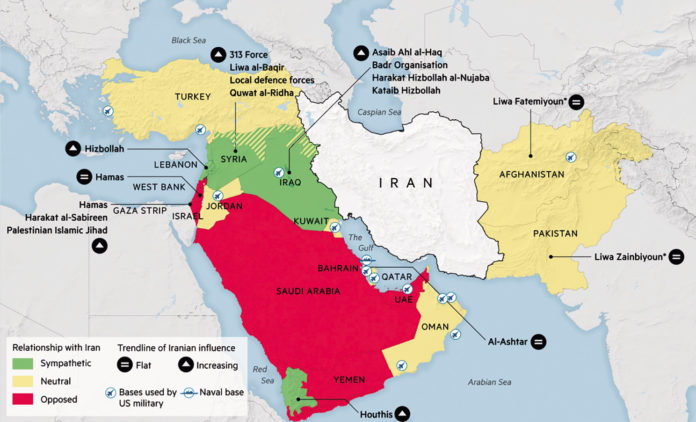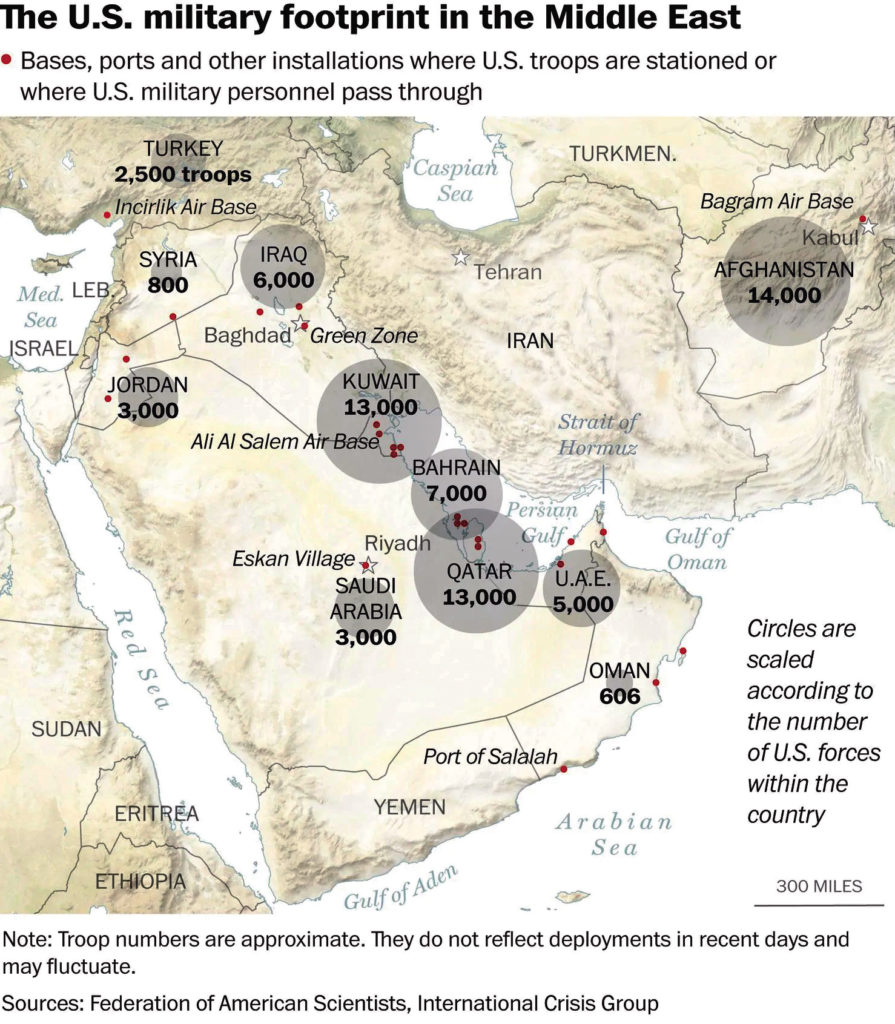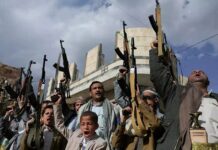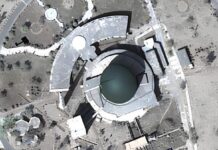Iran’s pledge to exact a ‘crushing revenge’ on American forces in retaliation for the killing of Quds commander Maj Gen Qassem Soleimani can leave the Middle East on the brink of a conflict that could quickly spiral into World War 3, dragging in other world powers including Russia, Turkey and China.
The threat of a major escalation in US-Iran tensions appears to be rising following General Soleimani’s death. Millions have expressed concern about the assassination and whether it could become the trigger for World War 3.
Tensions have been growing between the US and Iran since 2018 when Donald Trump announced the US would be withdrawing from the 2015 nuclear deal. Additionally, an independent US report warned the stage had been set for a full-scale war, with the US President filling his administration with hardliners.
However, World War 3 is not official and no nations have as yet declared war on another.
Likely Iranian Targets
The US embassy in Baghdad, which has been the target of attacks, is likely to see renewed action, while military patrols and bases could be hit by ground troops and improvised explosive devices (IEDs).
There are some 5,000 US troops currently stationed around Iraq, with more on the way, all of whom are now targets for Shia militias which have fought for Iran – and in some cases directly with Soleimani – in the past. Targets in Iran’s crosshairs may include US troops and military bases in Iraq and Syria, Israeli forces in the Golan Heights, tankers in the Strait of Hormuz, and Saudi Arabia’s oil infrastructure.
The Quds Force, which Solemani controlled for almost two decades, will orchestrate the attacks from behind the scenes and may become directly involved in order to avenge their beloved leader’s death. In the past, questions have been raised over whether Quds Forces operate independently of the regime in Tehran, raising the prospect of attacks even if not directly ordered by Tehran.
Escalatory Ladder
If Tehran decides to strike Israel, Golan Heights region could be trageted with Hezbollah providing support, though Tel Aviv has warned that Iranian missiles can range much further across its borders.
China has ships in the Gulf of Oman. China, Russia and Iran recently carried out joint naval drills.
Any escalation by Tehran through Iran-backed Houthi rebels in Yemen against Saudi Arabia would be met with a response from Riyadh.
Strikes on these targets could lead to a tit-for-tat series of events. Russian forces stationed in Syria defending a key Iranian ally in Bashar al-Assad, and Turkish forces fighting in the country’s north, could get involved. Turkish troops are deployed in northern Syria and. Being a member of NATO, Turkey’s actions would be unpredictable if a conflict escalates across the region. Turkey’s president Recep Erdogan is close to Russia and Iran as well.
Nuclear Weapons
US, China, Russia and Israel all have nuclear weapons – with at least three of those possessing next-generation hypersonic missiles capable of breaching all defence systems.
Israel is also armed with nuclear weapons and is an obvious target for any Iranian attacks, but Benjamin Netanyahu and the IDF will not hesitate to defend themselves and have recently struck Iran-backed Hezbollah forces in Syria.
In the case of conflict Iran could ramp up its nuclear programme. It has breached Uranium stockpile limits and has been enriching to above energy-grade levels since Trump cancelled the nuclear deal. It could begin enriching to weapons-grade levels in response to the latest threat. In that case, US warships, bombers and cruise missiles could be used to take out the facilities.
Strait of Hormuz
One of the most extreme option available to Iran would be closing the Strait of Hormuz completely, cutting off a fifth of the world’s daily oil supply. While Tehran has often threatened to close the waterway, such a move would almost certainly prompt a response from US carrier groups in the region as well as dragging in other world powers who rely on the oil.
Iran could choose to harass, disable or destroy oil tankers sailing in the Persian Gulf which separates it from the Arabia Peninsula, potentially disrupting a key source of income for the Saudis.
Iranian Forces
Iran has the world’s 13th most powerful military. In addition, there are a host of proxy militia forces spread across the Middle East, such as Lebanon’s Hezbollah and Yemen’s Houthi rebels, and allies like Syria’s Bashar al-Assad.
Iran can draw reserves from a population of some 82 million. It has an arsenal of ballistic missiles, tanks, attack helicopters, fast jets and gunboats.
Iran’s biggest asset is geography – surrounded on three sides by mountains, a fourth by ocean, and with a vast desert at its center, it poses a formidable obstacle – even for the US Army.
Cyber War
Cyber attacks have also become an increasingly popular method of warfare and could be used by both Iran, America and their allies to attempt to win an early upper hand.
Targets would likely include Iranian nuclear facilities – which were successfully targeted with the Stuxnet virus in the past – communications equipment, radar, power networks and other key infrastructure.
Stand-off Warfare
To nullify the threat of American drones, Iran could use anti-aircraft missiles to shoot them down, as it did in June 2019. Iranian missiles could also be trained on US warships around the Arabian Peninsula, including the Lincoln Carrier Strike Group, but this would be an extreme option and likely only taken after a ground invasion.
Syria
Bashar al-Assad is a close ally of Iran, and owes the continued existence of his regime in large part to the personal intervention of Soleimani, who helped him turn the tide of Syria’s years-long civil war along with Russia.
Assad could be persuaded to ignore attacks by pro-Iran militias against several hundred US troops and Kurds remaining in Syria after Donald Trump ordered a withdrawal.
Russia has ground forces stationed in Syria defending a key Iranian ally in Bashar al-Assad. Russia’s latest S400 anti-aircraft systems in Syria could be used against American jets and bombers in the event the crisis spirals into a wider war. If fighting escalates then Russian forces stationed across Syria could quickly become embroiled, along with Turkish forces currently deployed in the north.
ISIS will also likely exploit the situation to try and pit the sides against each-other, allowing them to seize back territory they lost in recent years.
Lebanon
The country is controlled by Hezbollah, an Iranian proxy fighting force, which has vowed ‘worldwide resistance’ following Soleimani’s death. The group could launch rocket attacks against targets in Israel, as well as anti-aircraft attacks against Israeli jets and drones operating in the region.
Iran also exerts control over Palestinian Islamic Jihad and Hamas, both of which operate in the Gaza Strip and could be used to cause further problems for Israel.
Saudi Arabia
Saudi Arabia has seen attacks against its oil infrastructure in recent months which were blamed on Tehran. Saudi oil infrastructure is likely to feature in Iran’s plans for strikes in the region, following on from major disruption caused after a drone and missile attack on the country’s largest oil refinery last year, though security was massively ramped up afterwards, making success far from a sure thing.
Yemen
Iran has been fighting a proxy-war in Yemen using Houthi rebels, fighting against Saudi forces which are allied to the ruling regime. Attacks against the Saudis could increase, and Iran could use Houthi drones and guided missiles to launch attacks against pipelines in Saudi Arabia and other infrastructure as it has done in the past.
Afghanistan
The US has just reached a ceasefire agreement with the Taliban in Afghanistan in an attempt to put an end to the longest war it has ever fought. But, as in Iraq and Syria, Iran has links with Shia militias across the region which it could leverage in an attempt to derail the process and plunge the region back into conflict, further extending US engagement there.
Qatar
The country houses the largest American military base in the Middle East, at Al Udeid, which is home to some 10,000 troops and dozens of fighters and bombers including F-22 fighters and B-52 bombers. If all-out war breaks out with Iran, then Al Udeid air base in Qatar will be at the center of US efforts to establish air superiority in the event of a wider war. There are dozens of aircraft at the base, including F-22 fighters and B-52 bombers.
U.S. Retaliation
The United States has a vast array of military hardware in the Middle East and Persian Gulf. Among the military options are F22 Raptor fighters based in Dubai, cruise missile-armed Ohio class submarines and aircraft carriers and US Special Forces who are still based in northern Iraq and Syria. Strategic assets such as B2 Stealth bombers can also strike by flying over from the US mainland, and – in the ultimate event – America can also field nuclear weapons fired from silos on the mainland at virtually anywhere in the world.
Russian Forces
Tens of thousands of Russian troops and aircraft are based in Syria in support of Bashar al-Assad’s regime. They include special forces and the feared S400 anti-aircraft missile – the most advanced missile system in the world. If the conflict escalates, Russia could feel compelled to defend its ally or Iran or retaliate if its troops are killed as collateral damage by the US. It could also use strategic assets based in Russia such long range missiles and long-range bombers, along with ships and submarines based in the Mediterranean at Sevastopol.
Israel’s Response
If Israel is attacked by Iran it is sure to retaliate. It has nuclear weapons and an array of advanced fighter jets capable of launching strikes at Iran and Iranian forces in Syria, as it has done in the past. Its special forces are also among the most feared in the world, and stationed across the region.
Most Likely Scenario
The most likely outcome will be an intensified period of proxy wars in Iraq, Syria, Lebanon and Yemen, staying just below the conventional threshold, given Iran’s inability to survive an overwhelming US’ “retaliatory” strike if Trump authorized one in response to the unlikely massive missile strike that some speculate Tehran might be preparing. The US might also carry out “surgical strikes” against places in Iran where it might claim other strikes were “organized”, such as an attempt to repeat the drone strike against Saudi Aramco from last September. “Decapitation strikes” might, therefore, become increasingly more frequent and nobody would be safe, since the US just signaled that it has the political will to take out “high-value targets”. As all of this unfolds, Russia and China will do their utmost to stay away from any regional fray and definitely would not intervene to defend Iran. As such, Iran’s expected responses will be purely asymmetrical and not conventional.



















